It is not often that a bucket of water is the central character in a three-hundred-year-long debate. But a bucket that belonged to Sir Isaac Newton is no ordinary bucket, and a little experiment he described in 1689 has deeply influenced some of the world’s greatest physicists ever since.

Take a bucket filled with water, hang it by a rope, twist the rope tightly so that it’s ready to unwind, and let it go. At first, the bucket starts to spin but the water inside remains fairly stationary; the surface of the stationary water stays nice and flat. As the bucket picks up speed, little by little its motion is communicated to the water by friction, and the water starts to spin too. As it does, the water’s surface takes a concave shape, higher at the rim and lower in the center.
That’s the experiment-not quite something that gets the heart racing. But a little thought will show that this bucket of spinning water is extremely puzzling. And coming to grips with it, as we have not yet done in over three centuries, ranks among the most important steps toward grasping the structure of the universe
The most beautiful thing we can experience is the mysterious. It is the source of all true art and science
“Relativity” is a word we associate with Einstein, but the concept goes much further back. Galileo, Newton, and many others were well aware that velocity –the speed and direction of an object’s motion- is relative. In modern terms, from the batsman's point of view, a well-pitched ball might be approaching at 100 miles per hour. From the ball’s point of view, it’s the batsman who is approaching at 100 miles per hour. Both descriptions are accurate; it’s just a matter of perspective.

Motion makes sense only in a relational sense: An object’s velocity can be specified only in relation to that of another object. You have probably experienced this. When the train you are on is next to another, you see relative motion. If both trains are moving in the same direction with the same speed, for people looking out the window it looks as though they are not moving.
When you are inside a moving car you can tell by looking at the speedometer, at what speed the car is moving. 20 mph, 60 mph or whatever but what does it mean? If a car is moving at 20mph, it means that assuming the surface it is moving on is stationary, the car travels 20 miles in a specific direction during one hour's time. So to make sense of speed we had to assume that the Earth was not moving.

Does this mean that the car’s speed wasn’t 20 mph? Of course, if we are taking Earth’s motion into account, it would mean that the velocity of our car would be different. In this case, the only difference is that we are measuring speed by assuming the Sun as stationary instead of the Earth. So the velocity of the car would be 20mph added to the velocity of the Earth. Just think of it as if the car is now moving on a train that is also moving at 20mph. For a person standing outside, it will look like you are moving double the speed of the train.
When we left the bucket, both it and the water were spinning, with the water forming a concave shape. The issue Newton raised is, why does the water’s surface take this shape? Well, because it’s spinning you say, and just as we feel pressed against the side of a car when it takes a sharp turn, the water gets pressed against the side of the bucket as it spins. And the only place for the pressed water to go is upward. This reasoning is sound, as far as it goes, but it misses the real intent of Newton’s question. He wanted to know what it means to say that the water is spinning: spinning with respect to what?
A natural suggestion is to use the bucket itself as the object of reference. As Newton argued, however, it fails. You see, at first as the bucket starts to spin, there is definitely relative motion between the bucket and the water because the water doesn’t immediately move. Even so, the surface of the water stays flat. Then, a little later, when the water is spinning and there isn’t relative motion between the bucket and the water, the surface of the water is concave. So, with the bucket as our object of reference, we get exactly the opposite of what we expect: when there is relative motion, the water’s surface is flat; and when there is no relative motion, the surface is concave.

The astronaut can feel spinning motion but in complete darkness what could serve as a reference point relative to which this motion can be measured.
Let’s imagine we have a huge bucket-one as large as an amusement park ride-that is floating in the darkness of empty space and imagine that a fearless astronaut is strapped to the bucket’s interior wall. The telltale sign that the bucket is spinning, the analog of the water being pushed outward yielding a concave surface, is that the astronaut will feel pressed against the inside of the bucket, his facial skin pulling taut and his hair straining back to the bucket wall. Here is the question: in a totally empty space-no sun, no earth, no air, no anything-what could possibly serve as the “something” with respect to which the bucket is spinning?
The important thing is not to stop questioning. Curiosity has its own reason for existing
Newton fixed the ultimate container as the relevant frame of reference: space itself. He proposed that the transparent, empty arena in which we are all immersed and within which all motion takes place exists as real, physical entity, which he called absolute space. We can’t grab or clutch absolute space, we can’t taste or smell or hear absolute space, but nevertheless, Newton declared that absolute space is a something. It’s something, he proposed, that provides the truest reference for describing motion. An object is truly at rest when it is at rest with respect to absolute space and an object is truly moving when it is moving with respect to absolute space.
Newton used this proposal to explain the terrestrial bucket experiment in the following way. At the beginning of the experiment, the bucket is spinning with respect to absolute space but the water is stationary with respect to absolute space. That’s why the water’s surface is flat. As the water catches up with the bucket, it is now spinning with respect to absolute space, and that’s why its surface becomes concave. The bucket is but an example; the reasoning is of course far more general. According to Newton’s perspective, when you spin around on ice skates, you feel your arms being flung outward because you are accelerating with respect to absolute space. By contrast, if someone were able to spin the entire ice arena while you stood still, giving rise to the same relative motion between you and the ice, you would not feel your arms flung outward because you would not be accelerating with respect to absolute space.

Absolute space, in its own nature, without reference to anything external, remains always similar and unmovable
But what is absolute space, really? In dealing with this question, Newton responded with a bit of fancy footwork and the force of fiat. His words were, “Absolute space, in its own nature, without reference to anything external, remains always similar and unmovable.” That is, absolute space just is, and is forever. Period. For millennia, the philosophical parsing of space often arose in tandem with theological inquiries. God, according to some, is omnipresent, and an idea that gives space a divine character. Newton himself took a version of this idea, allowing space to be filled by “spiritual substance” as well as material substance. Absolute space, Newton declared, is the sensorium of God.
Some discoveries provide answers to questions. Other discoveries are so deep that they cast questions in a whole new light, showing that previous mysteries were misperceived through lack of knowledge. During the first decades of the twentieth century, Albert Einstein made two deep discoveries. Each caused a radical upheaval in our understanding of space and time. Einstein dismantled the rigid, absolute structure that Newton had erected, and built his own tower, synthesizing space and time in a manner that was completely unanticipated.
In the mid-1800s, Maxwell discovered four powerful equations that, for the first time, set out a rigorous theoretical framework for understanding electricity, magnetism, and their intimate relationship. Maxwell developed these equations by carefully studying the work of the English physicist Michael Faraday, who in the early 1800s had carried out tens of thousands of experiments that exposed hitherto unknown features of electricity and magnetism. Faraday’s key breakthrough was the concept of the field.

Magnetic fields around a bar magnet as traced by iron filings. ©dayna mason
There is no better way to get a visceral sense of a magnetic field than the elementary school demonstration in which iron filings are sprinkled in the vicinity of a bar magnet. After a little shaking, the iron filings align themselves in an orderly pattern of arcs. The pattern traced by the iron filings is direct evidence that the magnet creates an invisible something that permeates the space around it-a something that can, for example, exert a force on shards of metal. The invisible something is the magnetic field and, to our intuition, it resembles a mist or essence that can fill a region of space and thereby exert a force beyond the physical extent of the magnet itself.
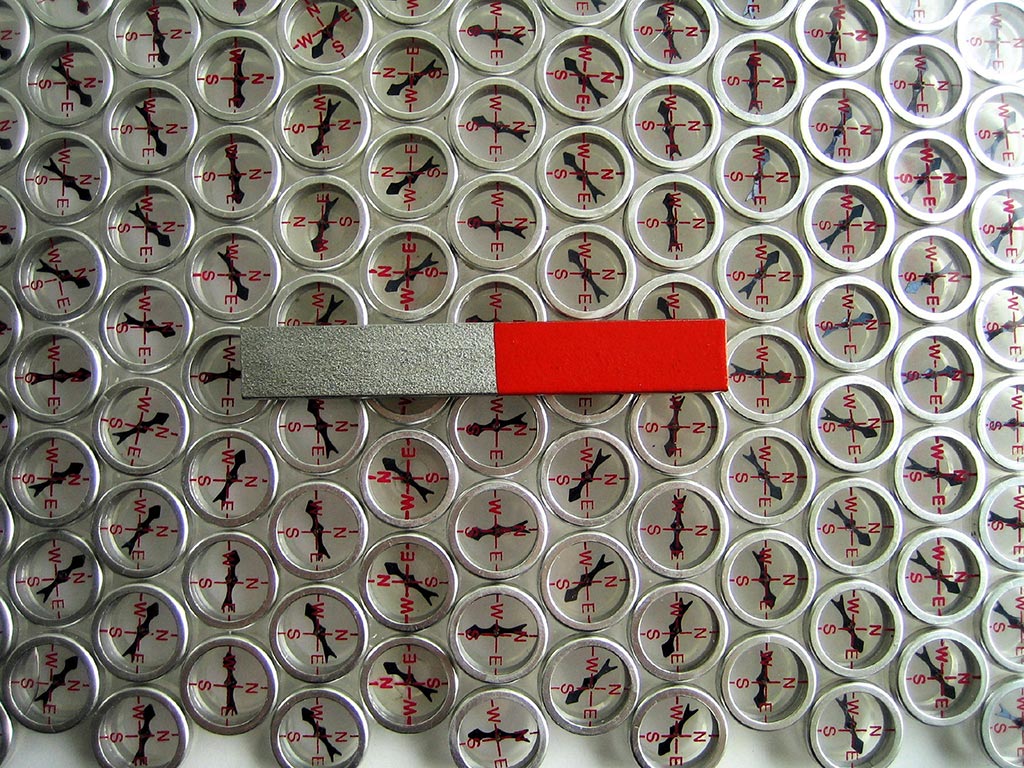
A compass detects slight magnetic fields created by an object and aligns itself accordingly. ©dayna mason
When you look at a compass, how is it that the needle swings around and points north even though nothing seems to nudge it? The answer to this question invokes the Earth’s magnetic field, which seeps through the compass casing and turns the needle, causing it to point along an arc that, as a result of eons-long geographical processes, is aligned in a nearly south-north direction.
Magnetic fields are one familiar kind of field, but Faraday also analyzed another: the electric field. And if you happened to examine a compass during such a storm, the way its magnetic needle deflected this way and that as the bolt of electric lightning flashed nearby would have given you a hint of a deep interconnection between electric and magnetic fields. Maxwell found the mathematical underpinnings of these interrelationships, and because his equations showed that electric and magnetic fields are as entwined, they were eventually christened electromagnetic fields, and the influence they exert the electromagnetic force.
Upon further analyzing his equations, Maxwell found that changes or disturbances to electromagnetic fields travel in a wavelike manner at a particular speed: 670 million miles per hour. As this is precisely the value other experiments had found for the speed of light, Maxwell realized that light must be nothing other than an electromagnetic wave, one that had the right properties to interact with chemicals in our retinas and give us the sensation of sight. This achievement made Maxwell’s already towering discoveries all the more remarkable but it also raised a deep question.
When we say that the speed of light is 670 million miles per hour, experience, and our discussion so far, teach us this is a meaningless statement if we don’t specify relative to what this speed is being measured. The funny thing was that Maxwell’s equations just gave this number without specifying or apparently relying on any such reference. Most physicists, including Maxwell, attempted to explain the speed his equations gave in the following way: Familiar waves such as ocean waves or sound waves are carried by a substance, a medium. Ocean waves are carried by water. Sound waves are carried by air. And the speed of these waves is specified with respect to the medium.

Ocean waves are carried by water and surfers when riding a wave have no relative motion between the wave and them.
Naturally, then, physicists surmised that light waves-electromagnetic waves-must also travel through some particular medium, one that had not been seen or detected but that must exist and they called it the ‘luminiferous aether’. As you can see, there is a striking similarity between the aether and Newton’s absolute space. They both originated in attempts to provide a reference for defining motion; accelerated motion led to absolute space, light’s motion led to the aether. Many physicists viewed the aether as a down-to-earth stand-in for the divine spirit that others had envisioned permeating absolute space. But what actually is the aether? What is it made of? Where did it come from? Does it exist everywhere?
Experiments for absolute space involved spinning around in a completely empty universe but physicists were able to propose doable experiments to determine whether the aether really existed. For example, if you swim through the water toward an oncoming wave, the wave approaches you more quickly; if you swim away from the wave, it approaches you more slowly. Similarly, if you move through the supposed aether toward or away from an oncoming light wave, the light wave’s approach should, by the same reasoning, be faster or slower than 670 million miles per hour.
An experiment is a question which science poses to Nature, and a measurement is the recording of Nature’s answer
In 1887, Albert Michelson and Edward Morley conducted experiments using an interferometer to measure the speed of light, but time and time again they found exactly the same speed of 670 million miles per hour regardless of their motion or that of the light’s source.
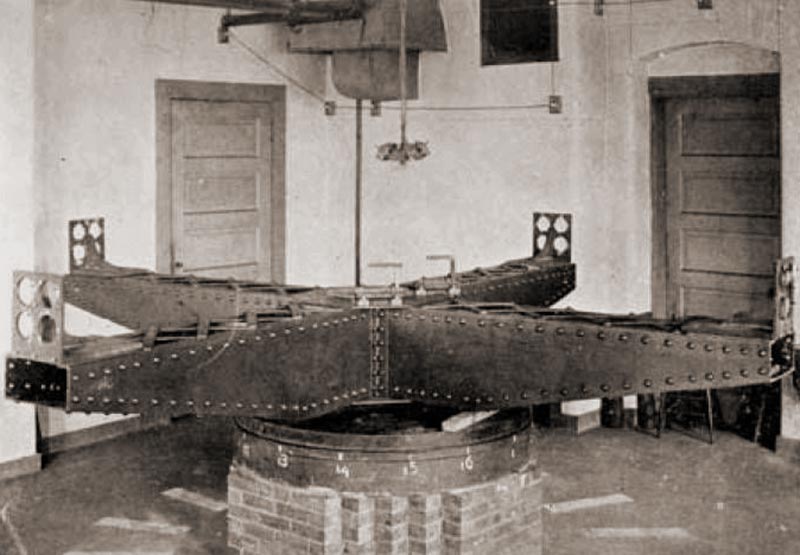
In 1905, Einstein published the ‘Theory of Special Relativity’, which once and for all spelled the end of luminiferous aether. As a teenager, Einstein struggled with the question of what a light wave would look like if you were to chase after it at exactly light speed. Since you and the light wave would be zipping through the aether at exactly the same speed, you would be keeping perfect pace with the light. And so, Einstein concluded, from your perspective, the light should appear as though it wasn’t moving. You should be able to reach out and grab a handful of motionless light.
But here’s the problem. It turns out that Maxwell’s equations do not allow light to appear stationary-to look as if it’s standing still. And certainly, there is no reliable report of anyone’s ever actually catching hold of a stationary clump of light. So, the teenage Einstein asked, what to make of this apparent paradox?
Einstein was aware of at least some experiments that had failed to detect evidence for the existence of the aether. So why dance around trying to find fault with the experiments? Instead, Einstein declared, take the simple approach: The experiments were failing to find the aether because there is no aether. And since Maxwell’s equations describing the motion of light-the motion of electromagnetic waves-do not invoke any such medium, both experiment and theory would converge on the same conclusion: light, unlike any other kind of wave ever encountered, does not need a medium to carry it along. Light is a lone traveler. Light can travel through empty space.

The problem is that it also seems crazy. If you run after a departing beam of light, common sense dictates that from your perspective the speed of the departing light has to be less than 670 million miles per hour. Throughout his life, Einstein challenged common sense, and this time was no exception. He forcefully argued that regardless of how fast you move toward a beam of light, you will always measure its speed to be 670 million miles per hour-not a bit slower, no matter what. This would certainly solve the paradox that stumped him as a teenager. But we naturally ask, how can light possibly behave in such a strange manner?
The universe has its own constants, in the form of unvarying quantities that endlessly reappear in nature and in mathematics, and whose exact numerical values are of signal importance to the pursuit of science
If there is no aether to provide the standard of rest, what is the ‘what’ with respect to which the speed of light is to be interpreted? Again, Einstein answered with ultimate simplicity. If Maxwell’s theory does not invoke any particular standard of rest, the most direct interpretation is that we don’t need one. The speed of light Einstein declared is 670 million miles per hour “relative to anything and everything.”
Time exists in and of itself and flows equably without reference to anything external
Ever since Newton, space had been thought of as absolute, as being out there, as existing “without reference to anything external.” Newton declared the same to be true of time. “Time exists in and of itself and flows equably without reference to anything external.” In other words, according to Newton, there is a universal, absolute conception of time that applies everywhere. These assumptions about space and time comport with our daily experiences and that is the basis for our commonsense conclusion that light should appear to travel more slowly if we move after it.
But what about the Bucket? While many viewed the luminiferous aether as the physical substance giving credibility to Newton’s absolute space, it had nothing to do with why Newton introduced absolute space. Instead, after wriggling with accelerated motion such as the spinning bucket, Newton saw no option but to invoke some invisible background stuff with respect to which motion could be unambiguously defined. Doing away with the aether did not do away with the bucket, so how did Einstein cope with the issue? Up until now, Einstein’s main focus had been on a special kind of motion: constant-velocity motion. It was not until 1915, some ten years later, that he fully came to grips with more general, accelerated motion, through his ‘Theory of General Relativity.’
Perhaps there is no better way to understand the theory of relativity than to grasp the concept of ‘time dilation’. Time as Newton thought is not absolute. Time passes differently in different situations. When you are inside a moving car or train, time ticks off a little slow for you than for those outside. Your wristwatch and of the people outside fall out of synchronization. Your second is not equal to their second. However this phenomenon is only observable at very high speeds and because we do not move fast enough in our daily lives, we have never experienced this.

We are used to thinking about space as the arena of the universe, but physical processes occur in some region of space during some interval of time. Until 1905, it was thought that everyone experiences the passage of time identically, that everyone agrees on what events occur at a given moment of time. But when Einstein realized that two observers in relative motion have clocks that tick off time differently, this all changed. Clocks that are moving relative to each other fall out of synchronization and therefore give different notions of simultaneity-they do not agree on what things happen at the same time.
Speed is the distance traveled in a given amount of time. For example, if you travel 60 miles in one hour, your speed is 60 miles per hour. We can easily change our speed by accelerating and decelerating. In order for the speed of light to be constant, even if the light is “launched” from a moving object, only two things can be happening. Either something about our notion of distance or something about our notion of time must be skewed. As it turns out, both are skewed.
A Newtonian physicist, by presuming space and time to be absolute, is forced to conclude that the speed of light is relative-it depends on one’s state of motion. Einstein, by presuming the speed of light to be absolute, was forced to conclude that space and time are relative-they depend on one’s state of motion
The relativity of space and time is a startling conclusion. From the well-worn statement that the speed of light is constant, we conclude that space and time are in the eye of the beholder. Each of us carries our own clock, our own monitor of the passage of time. Each clock is equally precise, yet when we move relative to one another, these clocks do not agree. They measure a different amount of elapsed time between two chosen events. The same is true of distance. Each of us carries our own yardstick, our own monitor of distance in space. Each yardstick is equally precise, yet when we move relative to one another, these yardsticks do not agree; they measure different distances between two locations. If space and time did not behave this way, the speed of light would not be constant and would depend on the observer’s state of motion.
We are used to the fact that objects can move through space, but there is another kind of motion that is equally important: objects also move through time. Right now, the watch on your wrist and the clocks on the wall are ticking away, showing that you and everything around you are relentlessly moving through time, relentlessly moving from one second to the next and the next. Newton thought that motion through time was totally separate from motion through space-he thought these two kinds of motion had nothing to do with each other. But Einstein found that they are intimately linked.
The task is not so much to see what no one has yet seen; but to think what nobody has yet thought, about that which everybody sees
To get a fuller sense of what Einstein found, imagine a car heads due north at speed of 65 miles per hour and then merges onto a highway pointing in the northeasterly direction. The car’s speed in the northward direction would be less than 65 miles per hour. The reason is clear. Initially, all its speed was devoted to northward motion, but when the car shifted direction some of that speed was diverted into eastward motion, leaving a little less for heading north. This extremely simple idea actually allows us to capture the core insight of special relativity.
When you look at something like a parked car, which from your viewpoint is stationary-not moving through space, that is- all of its motion is through time. The car, its driver, the street, you, your clothes are all moving through time in perfect sync: second followed by second, ticking away uniformly. But if the car speeds away, some of its motion through time is diverted into motion through space. Just like speed in the northward direction slowed down when the car diverted into eastward motion, the speed of the car through time slows down when it diverts some of its motion through time into motion through space. That, in a nutshell, is special relativity.
Space is the three-dimensional representation of everything we observe and everything that occurs. Space allows objects to have lengths in the left/right, up/down, and forward/backward directions. Time is the fourth dimension. In normal life, time is a tool we use to measure the procession of events of space. But time is something more. Yes, we use time as a “tool”, but time is essential for our physical existence. Space and time when used to describe events can't be clearly separated. Therefore, space and time are woven together in a symbiotic manner. Having one without the other has no meaning in our physical world. To be redundant, without space, time would be useless to us and without time, space would be useless to us. This mutual dependence is known as the Spacetime Continuum. It means that any occurrence in our universe is an event of Space and Time.
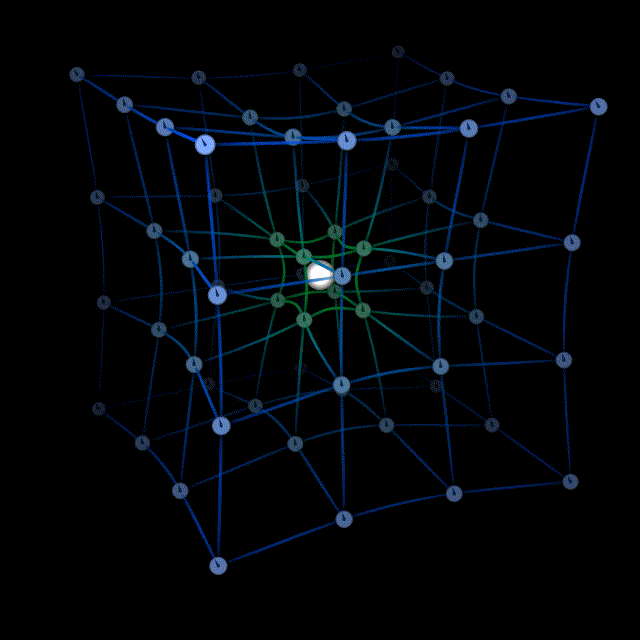
Time is the fourth dimension. ©LucasVB
Thus, although Newton definitely got it wrong, his intuition that there was something absolute, something that everyone would agree upon, was not fully debunked by special relativity. Absolute space does not exist. Absolute time does not exist. But according to special relativity, absolute spacetime does exist. So in an otherwise empty universe, spacetime not space, provides the benchmark with respect to which the bucket is spinning.
Einstein then turned his attention towards accelerated motion. Spacetime did provide the something with respect to which the bucket spins but it did not solve the problem entirely. Why was accelerated motion different than other motion? Why exactly the spinning water formed that concave shape? Why do we feel pressed against the side of the car when it is taking a turn? Accelerated motion, Einstein knew was different than constant-velocity motion because we can feel it, but to find the reason behind it Einstein went deeper into the mystery and emerged enlightened.
Einstein realized that special relativity, with its central dictum that the speed of light is the fastest that anything can travel, was in direct conflict with Newton’s universal law of gravity, the monumental achievement that had for two hundred years predicted with fantastic precision the motion of moon, the planets, comets, and all things tossed skyward. He realized that according to Newton, gravity exerts its influence from place to place, from the sun to the earth, from the earth to the moon, from any-here to any-there, instantaneously, in no time at all, much faster than light. And that directly contradicted special relativity.
I leave this problem to the consideration of the reader
Einstein’s journey toward general relativity began with a key question that Newton had sidestepped two centuries earlier. How does gravity exert its influence over immense stretches of space? How does the vastly distant sun affect earth’s motion? The sun doesn’t touch the earth, so how does it do that? In short, how does gravity get the job done? Although Newton discovered an equation that described the effect of gravity with great accuracy, he fully recognized that he had left unanswered the important question of how gravity actually works. In his book, Newton wrote, “I leave this problem to the consideration of the reader.”
In special relativity, Einstein’s main focus was on observers who move with constant velocity-observers who feel no motion and hence are all justified in proclaiming that they are stationary and that the rest of the world moves by them. But accelerated motion is different because you can feel it. You feel squeezed back into a car seat as it accelerates forward, you feel pushed sideways as a train rounds a sharp bend, you feel pressed against the floor of an elevator that accelerates upward.
The forces you’d feel struck Einstein as very familiar. As you approach a sharp bend, for example, your body tightens as you brace for the sideways push, because the impending force is inevitable. There is no way to shield yourself from its influence. The only way to avoid the force is to change your plans and not take the bend. This rang a loud bell for Einstein. He recognized that exactly the same features characterize the gravitational force. If you’re standing on planet earth you are subject to planet earth’s gravitational force. It’s inevitable. There is no way around it. In one of those flashes of insight that scientists spend a lifetime longing for, Einstein realized that gravity and accelerated motion are two sides of the same coin.
Just as by changing your planned motion, to avoid accelerating, you can avoid feeling squeezed back in your car seat or feeling pushed sideways on the train, Einstein understood that by changing your motion you can avoid feeling the usual sensation associated with gravity’s pull. The idea is wonderfully simple. To understand it, imagine a skydiver is free falling through the air with a weighing balance attached to his feet. The balance would give a reading of zero weight because there is no gravitational force acting on the skydiver. The feeling that a skydiver has in free fall is the same that an astronaut feels in space. Thus, by changing our state of motion-by fully “giving in to gravity”-we can simulate a gravity-free environment.

Similarly, by a suitable change in motion, you can create a force that is essentially identical to gravity. For example, imagine that the skydiver joins astronauts floating weightless in their space capsule, with the weighing balance stuck to his feet and still reading zero. If the capsule should up its boosters and accelerate, things will change significantly. The skydiver will feel pressed to the capsule’s floor, just as you feel pressed to the floor of an upward accelerating elevator. And since the skydiver’s feet are now pressing against the weighing balance, its reading is no longer zero. Through appropriate acceleration, the skydiver is now experiencing a force that is indistinguishable from gravity.
The same is true for other kinds of accelerated motion. Should the skydiver join the fearless astronaut in the outer space bucket, and, as the bucket spins, stand with feet and the weighing balance against the inner bucket wall-the balance will register a non-zero reading since his feet will press against it. If the bucket spins at just the right rate, the acceleration of the spinning bucket can also simulate earth’s gravity. Take a look at what it means. Right now you feel gravity’s influence. If you are sitting on a chair, you feel the chair supporting your weight. And unless you are moving in a car or train, you probably think that you are also stationary. But according to Einstein you actually are accelerating.
Since gravity and acceleration are equivalent, if you feel gravity’s influence, you must be accelerating. Einstein argued that only those observers who feel no force at all-including the force of gravity-are justified in declaring that they are not accelerating. Such free-force observers provide the true reference points for discussing accelerated motion, and it’s this recognition that requires a major turnabout in our way of thinking. When the skydiver is free falling, we would ordinarily describe him as accelerating down toward the earth’s surface. But this is not a description Einstein would agree with. According to Einstein, the skydiver is not accelerating. He feels no force. He is weightless. He provides the standard against which all motion should be compared.
Einstein was able to invoke this idea to profound effect. He understood that gravity itself must be nothing more than warps and curves in the fabric of spacetime. Let’s see what this means. If you roll a marble along a smooth wooden floor, it will travel in straight line. But if you’ve recently had a terrible flood and the floor dried with all sorts of bumps and warps, a rolling marble will no longer travel along the same path. Instead, it will be guided this way and that by the warps and curves on the floor’s surface. Einstein applied this simple idea to the fabric of the universe.
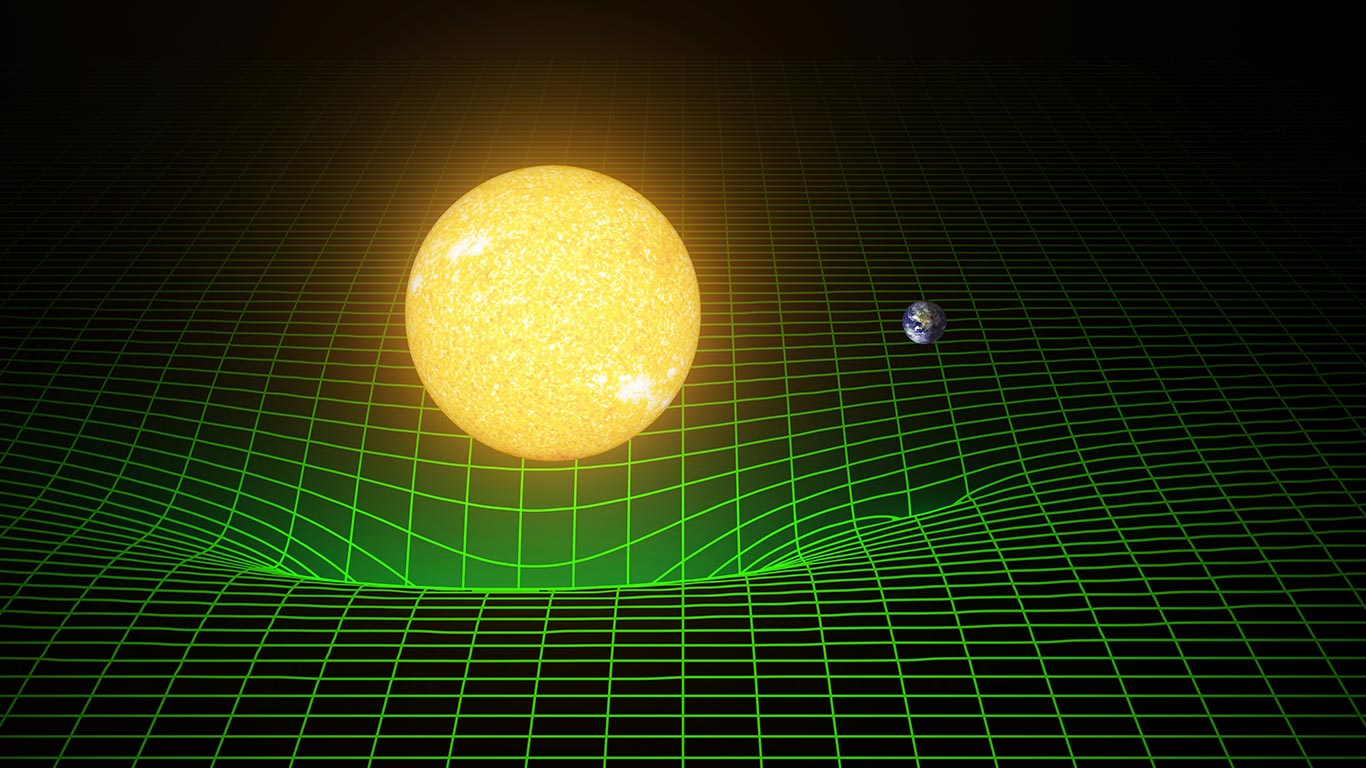
The gravity of massive bodies warps the fabric of space and time—and those bodies move along paths determined by this geometry. ©T. Pyle/Caltech/MIT/LIGO Lab
He imagined that in the absence of matter or energy-no sun, no earth, no stars-spacetime, like the smooth wooden floor, has no warps or curves. It’s flat. The presence of matter or energy has an effect on space much like the effect the flood had on the floor. Matter and energy, like the sun, cause space to warp and curve. And just as a marble rolling on the warped floor travels along a curved path, Einstein showed that anything moving through warped space-such as the earth moving in the vicinity of the sun-will travel along a curved trajectory.
We exist in a locally curved region of space and time created by the mass of the earth. The tug we feel downward as we stand by our beds in the morning is the sensation of our daily slide down that well in spacetime, a slope heading inward toward the center of the earth
That, according to Einstein, is how gravity exerts its influence. The same idea applies closer to home. Right now your body would like to slide down an indentation in the spacetime fabric caused by the earth’s presence. But your motion is being blocked by the surface on which you are sitting. Einstein viewed the warping of spacetime as the manifestation-the geometrical embodiment-of a gravitational field.
Since general relativity specifies the detailed mechanism by which gravity works, it provides a mathematical framework for determining how fast it transmits its influence. The speed of transmission comes down to the question of how fast the shape of space can change in time. That is, how quickly can warps and ripples-ripples like that on the surface of a pond caused by a plunging pebble-race from place to place through space? Einstein found that warps and ripples-gravity that is-do not travel from place to place instantaneously, as they do in Newtonian calculations of gravity. Instead, they travel at exactly the speed of light. Not a bit faster or slower, fully in keeping with the speed limit set by special relativity.
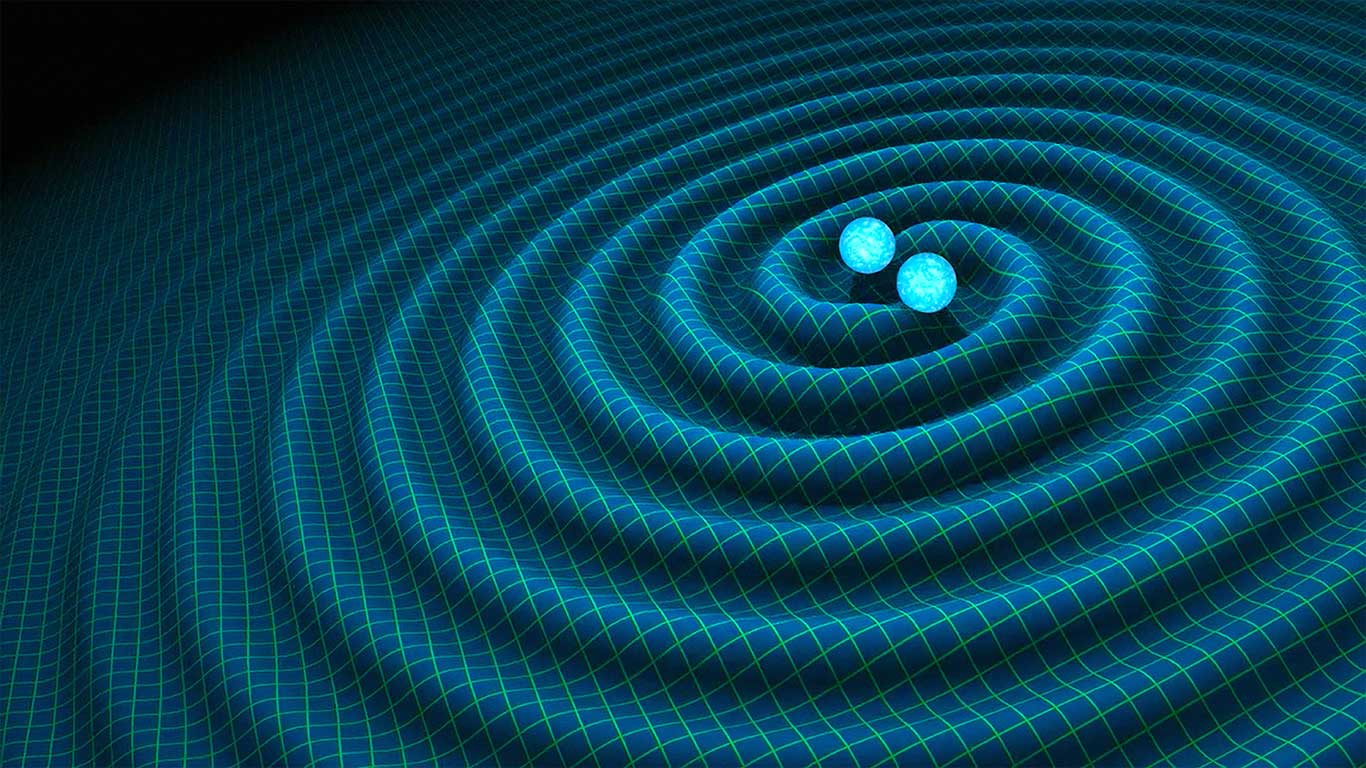
An artist's illustration of two black holes spiraling together, creating gravitational waves in the process. ©R. Hurt/Caltech-JPL
Although instruments can neither see nor measure space-time, several of the phenomena predicted by its warping have been confirmed. One such phenomenon is the existence of gravitational waves. Einstein predicted that massive accelerating objects such as neutron stars or black holes orbiting each other would disrupt space-time in such a way that 'waves' of distorted space would radiate from the source like the movement of waves away from a stone thrown into a pond.
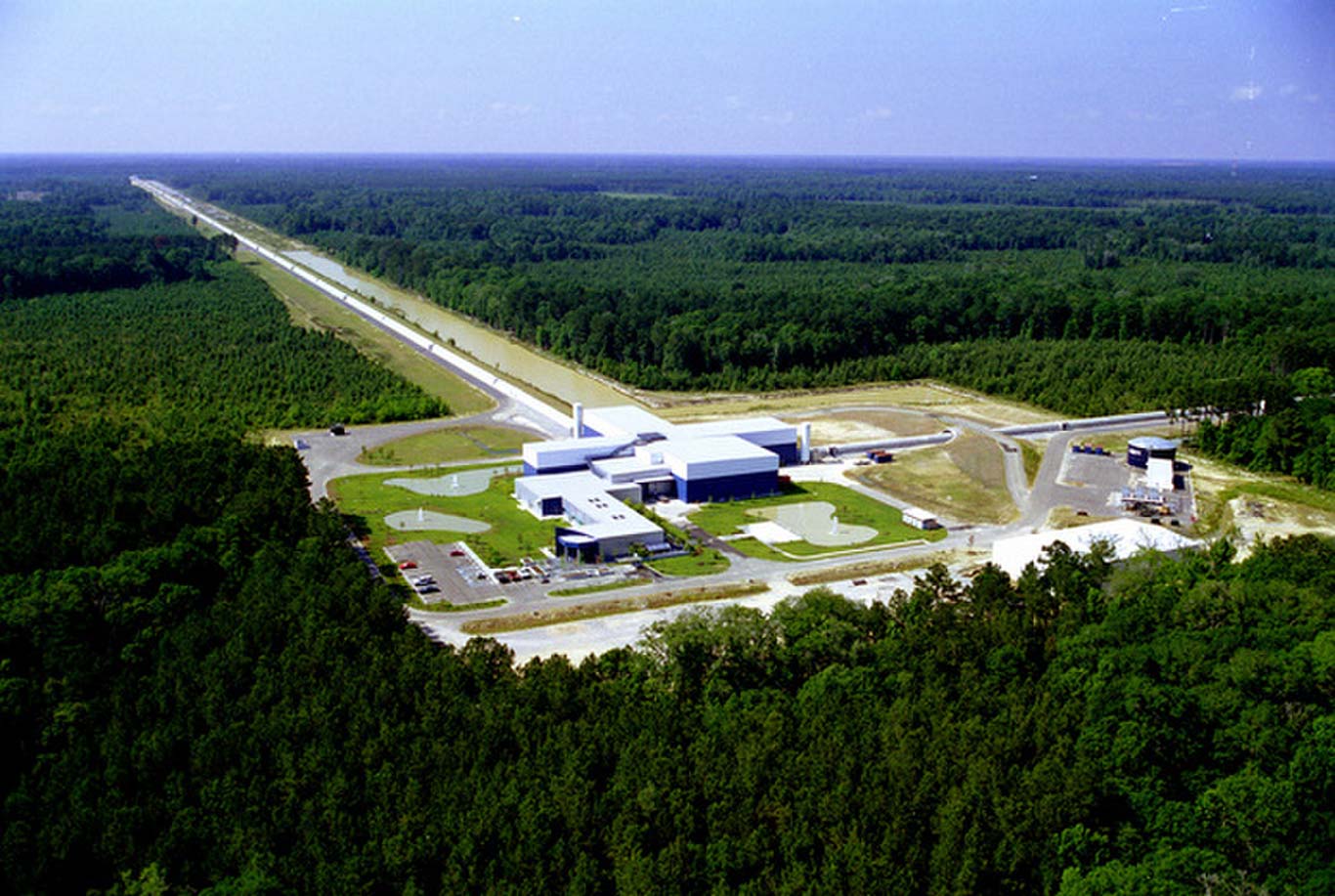
The Laser Interferometer Gravitational-wave Observatory (LIGO) facility in Louisiana. Another LIGO detector operates in Washington state. Courtesy Caltech/MIT/LIGO Laboratory
In September 2015, the historic first gravitational-wave signal, caused by two colliding black holes nearly 1.3 billion light-years away, was spotted by the Laser Interferometer Gravitational-wave Observatory (LIGO), a project that operates two detectors — one in Washington, and the other in Louisiana. This detection was achieved by using powerful “interferometers” that can detect minuscule warps in space-time. The project is based on the principle of Michelson interferometers, from the famous Michelson-Morley experiment in 1887. LIGO claims the waves carry origins about the universe and the nature of gravity.
There is nothing so far removed from us as to be beyond our reach or so hidden that we cannot discover it
The spinning bucket has had a long run. From Newton’s absolute space and absolute time to Einstein’s realization in special relativity that space and time are relative and yet in their union fill out absolute spacetime, to his subsequent discovery in general relativity that spacetime is a dynamic player in the unfolding cosmos, the bucket has always been there.
Space and time are dynamic in general relativity; they respond to the presence of mass and energy; they are not absolute. Spacetime and, in particular, the way it warps and curves, is an embodiment of the gravitational field. The benchmarks for all motion and accelerated motion, in particular, are freely falling observers-observers who have fully given in to gravity and are being acted on by no other forces. The gravitational force to which a freely falling observer acquiesces arises from all the matter and energy spread throughout the cosmos.

